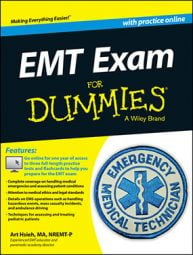Make sure you know about infectious diseases for the EMT exam. The immune system works to protect you from infectious diseases, which are transmitted from one person to the next. Infectious diseases range from illnesses such as a simple cold to very contagious and serious conditions like tuberculosis and meningitis.
Again, the immune system sends a wide variety of white blood cells to seek and destroy the invading contagion. The body also increases its temperature in the hopes of destroying the foreign cells without damaging too many of its own. If the illness is food or water borne, the GI tract will speed up its process, causing diarrhea.
The immune system works very well to ward off infections. However, sometimes the infection is overwhelming, the immune response is too weak, or toxins are produced when the body is killing the foreign cells. What may have started as a localized infection becomes a generalized one, affecting the entire body.
The fever and diarrhea cause dehydration. The vascular system reacts to the toxins by dilating. These two events can combine to cause septic shock. This is a dangerous situation that requires hospital care quickly. As with other forms of shock, treat septic shock quickly by keeping the patient supine, providing oxygen when indicated, and maintaining body temperature.
As an EMT, you want to minimize the chance of receiving exposure to an infection. This means staying healthy yourself so that your immune system functions at its best. Keep your vaccinations up to date. Washing your hands thoroughly after each patient contact, even if you wore gloves, is a highly effective way to break the chain of infection.
Patients experience shock for many reasons. Read all the information that’s provided in test questions to determine the underlying cause.
A 47-year-old female is unresponsive in her bed. She has had a cough for a week that produces green-colored sputum, and she’s had nausea, vomiting, and diarrhea for 36 hours. She has ovarian cancer and diabetes. Her blood pressure is 84/64 mm Hg, her pulse rate is 110, and she’s breathing 24 times per minute. Her skin is hot to the touch, pale, and dry. You should
(A)contact her physician for more information about the ovarian cancer.
(B)sit her up to help her breathe; assist with ventilations.
(C)keep a sheet over her and administer supplemental oxygen.
(D)provide oral glucose and transport in a semi-Fowler’s position.
The correct answer is Choice (C). The patient presents in shock, possibly from an infection. Treating for shock is appropriate. She is not awake, so giving her anything orally, as Choice (D) suggests, could compromise her airway.
Her blood pressure is too low to have her sit up, and assisting ventilations in that position, as indicated by Choice (B), is challenging. Finding out more about her medical history, as Choice (A) suggests, isn’t likely to change the way you treat her condition.

